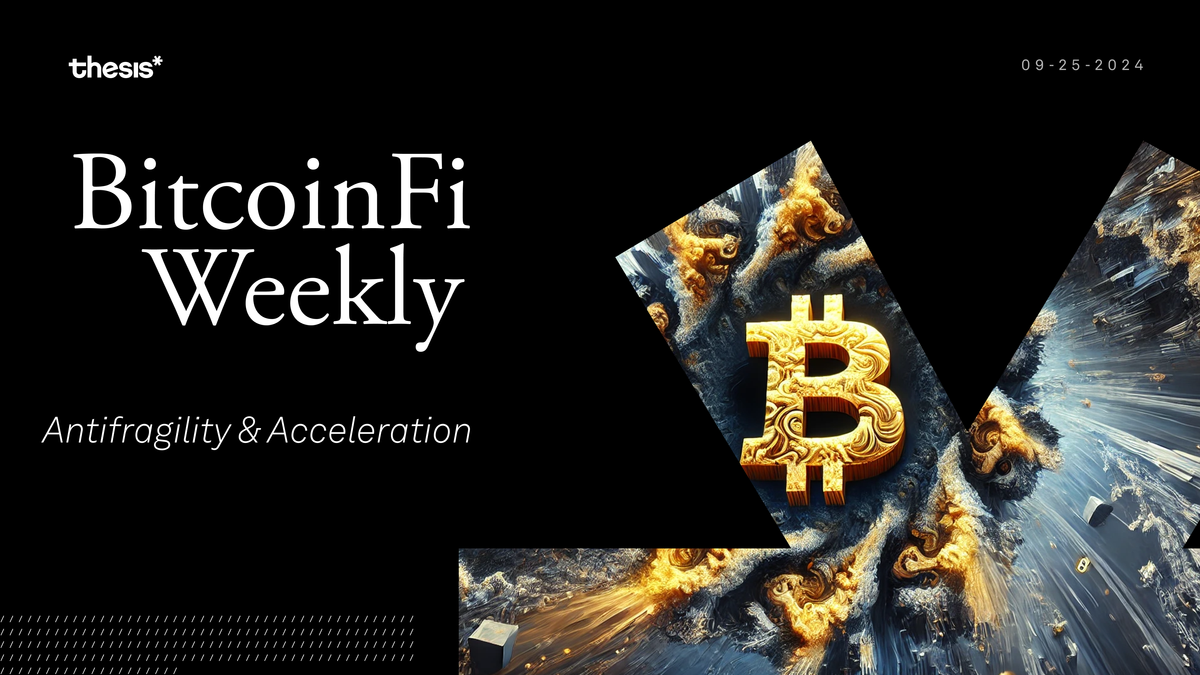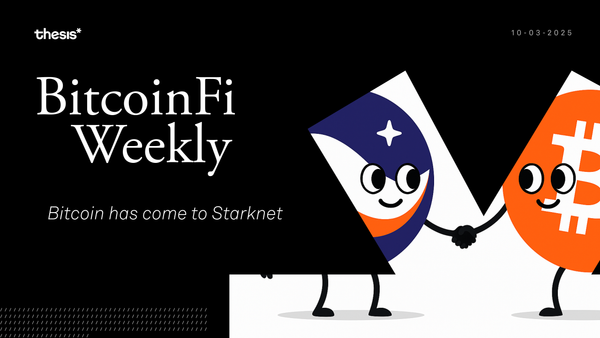Antifragility and Acceleration
We examine the intricacies of Bitcoin's antifragile nature, we'll explore how it has become a barometer for global liquidity. Citrea’s Testnet is live, tBTC is making waves on Aave, and STARK proofs are pushing the boundaries of what's possible on-chain.

Welcome to BitcoinFi Weekly. We cover where people use their BTC and what is changing in the Bitcoin world.
As summer’s warmth fades, we reflect on a season marked by uncertainty—a time where the choppiness in financial markets mirrored the wider world. Bitcoin, too, felt the tremors, navigating through the noise of fluctuating interest rates and wavering confidence. Yet, just as the leaves prepare to fall, so too did interest rates, reinvigorating the financial landscape with newfound energy.
In this edition of BitcoinFi Weekly, we examine the intricacies of Bitcoin's antifragile nature, we'll explore how it has become a barometer for global liquidity, outperforming traditional assets in ways that challenge conventional financial wisdom. Scalability is moving fast—faster than anyone expected. Citrea’s Testnet is live, tBTC is making waves on Aave, and STARK proofs are pushing the boundaries of what's possible on-chain.
Here’s this week’s rundown:
💪 Feature Piece: Bitcoin is Antifragile
📊 Alkimiya— The Bitcoin Blockspace Market
🍊 Citrea’s Testnet is Live
🛡️ Enhancing Privacy and Efficiency with Shielded Client-Side Validation
🔐 zkCoins Redefine Bitcoin Transactions
🧮 STARK Proof Verification on Bitcoin
🎉 tBTC is Live on Aave
Feature Piece: Bitcoin is Antifragile
The story of Bitcoin has always been one of bold experimentation, fraught with risk and controversy, yet undeniably driven by a singular vision: to create a new kind of financial independence, free from the constraints of centralized power. For years, it was regarded as a niche, even frivolous, tool—a speculative plaything of tech enthusiasts and the financially daring. But recently, that narrative has irrevocably changed.
With the SEC approving the listing and trading of Bitcoin ETF options, we're witnessing a profound shift in Bitcoin's role within the global financial ecosystem. Bitcoin is evolving into a barometer of global liquidity conditions. A new report shows that Bitcoin moves in the direction of global liquidity 83% of the time in any given 12-month period, outperforming even traditional assets like stocks, gold, and bonds. This unique characteristic positions Bitcoin as a key indicator of broader financial trends. As a result, the very institutions that once dismissed Bitcoin are now eagerly adopting it, building financial derivatives around it, and selling it to the masses. This institutional makeover will deepen liquidity, enhance adoption, and could very well bring about one of the most extraordinary episodes of volatility we've seen to date.
Let me explain. Previously, Bitcoin futures and options, whether on CME or platforms like Deribit, never quite solved the dilemma between capital efficiency and counterparty risk. Now, for the first time, Bitcoin will have access to a regulated marketplace where its synthetic notional exposure can grow without the counterparty risks that have previously stifled its appeal to institutional investors. However, a regulated ETF options market, where the OCC protects clearing members from default risk, adds a new dimension of credibility. Suddenly, Bitcoin just became a tool for institutional portfolio management. This means that Bitcoin can now function as a true financial asset, able to be leveraged, hedged, and managed within the safety net of a regulated options market. In a world driven by leverage, this is an opportunity for Bitcoin to rival traditional asset classes, not only in terms of financial utility but also in scale.
The options market introduces a new dynamic. Previously, traders had relied on perpetual contracts, instruments that were, at best, clumsy approximations of leverage. Now, investors can express long-term views on Bitcoin through derivatives that accurately capture its duration and volatility. With options, implied volatility tends to drop as prices rise, creating friction. Bitcoin, however, operates under a different set of dynamics. Its volatility is unpredictable, almost stochastic. Melt-ups are as likely as melt-downs, creating an environment where the actual volatility of volatility itself tilts toward infinite upside potential.
The peculiar nature of its volatility is what makes it truly singular. Unlike traditional assets, whose volatility skews toward the downside—where fear and panic drive prices lower—Bitcoin exhibits what is known as a volatility smile, where its potential for price melt-ups is just as great as its potential for collapses. This characteristic will play a critical role in the functioning of Bitcoin options as the asset’s price movements become increasingly self-reinforcing. The very design of these options allows for rising prices to drive volatility higher, which in turn drives more buying, creating a feedback loop that can push prices to unprecedented heights. Imagine a fire that feeds itself—each upward tick necessitates more buying, pushing the price further.
Lastly, the implications for miners are equally profound. Miners, the often-overlooked backbone of the Bitcoin network, will now find their role even more integral. As volatility increases and price action becomes more pronounced, miners will provide the stabilizing force that underpins Bitcoin’s floor. But perhaps more excitingly, the introduction of Bitcoin options gives us, for the first time, a view of its ceiling. As price appreciation feeds into more leverage, that ceiling will become harder and harder to grasp.
However, one immutable fact remains key: Bitcoin's supply can never be diluted. Unlike stocks, where companies can issue new shares to capitalize on favorable market conditions or commodities that can be manipulated through supply controls, Bitcoin’s supply is fixed. This means that its value is preserved, even as leverage increases. As Bitcoin becomes a more prominent feature in portfolios, its scarcity will only heighten its appeal. And now, armed with institutional prowess, Bitcoin will stand as the most unyielding and unassailable asset the world has ever seen.
BitcoinFi Updates
Alkimiya— The Bitcoin Blockspace Market
Alkimiya introduces a marketplace for trading Bitcoin transaction fees, offering users the ability to buy and sell blockspace.
Blockspace has seen significant volatility in transaction fees due to fluctuating demand. This volatility has posed challenges for both everyday users and businesses. Alkimiya’s platform provides a way to manage this by allowing participants to hedge against fee fluctuations, similar to how commodities markets manage pricing risk. The platform focuses on fee exposure over time, offering a more structured approach than traditional perpetual contracts. As Bitcoin uses a first-price auction system, miners naturally become sellers of transaction fees. As transaction fees become a larger share of miner revenue and with the growing prominence of concepts like MEV on Bitcoin, the need for a market-based solution has become more apparent. By enabling traders to engage with transaction fee dynamics and allowing businesses to mitigate volatility risks, Alkimiya aims to address the existing unpredictability in the blockspace market.
Citrea’s Testnet is Live
After a year and some change of heads down building, Citrea’s public testnet is finally live. The testnet operates on Bitcoin's Testnet4, allowing developers to build applications using Bitcoin as a settlement layer. Key features include a near-complete version of Clementine, Citrea's BitVM-based bridge, and infrastructure for multiple operator setups and malicious operator detection. Citrea's testnet implements a fixed bridging amount of 10 BTC and includes optimizations for proof production and inscription on Bitcoin. Citrea is also improving the prover system for generating zero-knowledge proofs, making it faster and more cost-efficient by optimizing data storage and handling. Future updates will include fraud proofs.
Enhancing Privacy and Efficiency with Shielded Client-Side Validation
Bitcoin enables users to transact without a trusted third party, but this comes with communication, computational, and privacy costs. Client-Side Validation (CSV) is a model that shifts transaction validation away from the blockchain, reducing these costs by sending transaction proofs directly to the recipient instead of broadcasting the entire transaction to the network.
However, traditional CSV protocols have limitations, including large proof sizes and privacy issues, since they reveal the coin’s transaction history to recipients. Shielded CSV improves upon this by offering the first private CSV protocol, where coin proofs reveal only the coin’s validity, not its transaction history. Key features include privacy (coin proofs reveal no information beyond validity and creation time), short coin proofs (size independent of transaction history), blockchain efficiency (only 64 bytes of data per transaction required on-chain), permissionless operation, efficient implementation using existing cryptographic primitives, trustless publishing, prunable wallet state, and support for advanced spending policies.
Although bridging between CSV and blockchain systems requires significant compression of coin proofs, potential solutions like BitVM could enable trustless bridges between systems. Shielded CSV has the potential to enhance Bitcoin privacy and support up to 100 transactions per second within current block size limits without impacting non-participating nodes.
zkCoins Redefine Bitcoin Transactions
zkCoins seeks to redefine Bitcoin's scalability and privacy by combining the client-side validation paradigm with Zero-Knowledge Succinct Non-Interactive Arguments of Knowledge (SNARKs) to enhance transaction efficiency without overburdening the Bitcoin blockchain. The protocol decouples Bitcoin transactions from its UTXO set, solving scalability issues seen in earlier solutions like Taro and RGB.
Unlike traditional Bitcoin transactions, where every node verifies each transaction, zkCoins allow recipients to validate the coin’s history with compressed proofs that require significantly less data, leading to increased throughput. This system leverages third-party Publishers to batch transactions, which are then committed on-chain, reducing costs and avoiding the bloat of Bitcoin's UTXO set. zkCoin’s distinctive feature is its privacy. Zero-knowledge proofs ensure that transaction histories are concealed while maintaining validity, providing "privacy for free" without exposing sensitive data on-chain.
This marks a notable evolution from privacy models like Zcash, which require large on-chain data commitments. By keeping most of the transaction data client-side, zkCoins offer a more scalable and private solution for payments and applications on Bitcoin. The project, currently under development by Robin Linus, Liam Egan, and Jonas Nick, is closely tied to BitVM's progress and faces ongoing challenges in optimizing proof construction and fee payment mechanisms. As development continues, with a prototype expected within a year, zkCoins stands poised to redefine Bitcoin's scalability and privacy.
STARK Proof Verification on Bitcoin
In the past year, significant strides have been made toward scaling Bitcoin with STARK proof verification. STARKs, a type of ZK Rollup, present an alternative to optimistic rollups by verifying off-chain computations directly on Bitcoin, avoiding the complexities of fraud proofs. While the cost of running a full verification is expected to be around $1000 per transaction, it is comparable to similar processes on Ethereum and can be optimized by combining it with other systems like BitVM. BitVM can handle small, frequent verifications throughout the day, while STARKs are used for larger, final settlements. This layered approach also creates opportunities for merged mining, improving miner alignment, and potentially reusing parts of the Lightning Network infrastructure to enhance scalability.
The development of STARK verification on Bitcoin involved overcoming technical challenges, such as finding a proof system that works within Bitcoin’s limited script capabilities. StarkWare focused on using smaller integer-based FRI systems to optimize for Bitcoin’s 32-bit signed addition and subtraction limits. Through collaboration with StarkWare and other partners, progress was made on two systems: BabyBear and M31 field-based systems, the latter providing substantial efficiency improvements through vectorized CPU instructions.STARK verification is expected to unlock new Bitcoin use cases, such as privacy payments, improved miner compensation distribution, and the potential for order books and AMMs. Although still in development, the Raito project, which implements a zero-knowledge Bitcoin client in Cairo, aims to provide trustless validation of the Bitcoin blockchain. This could revolutionize light clients, speed up initial block downloads, enable non-custodial bridges, and pave the way for even more Layer 2s on Bitcoin.
tBTC is Live on Aave
tBTC is now officially live on Aave v3, marking a major milestone in its five-year journey and for the greater BitcoinFi ecosystem. The proposal to onboard tBTC garnered overwhelming support, with 755,000 votes in favor, far surpassing the 320,000 votes needed for approval. Aave controls a significant portion of the Bitcoin liquidity market through wBTC, and tBTC’s addition to its v3 platform opens new opportunities for Bitcoin holders to earn yield while staying aligned with the core principles of decentralization.
The launch of tBTC on Aave comes at an ideal time, addressing increasing demand from institutional and DeFi participants for decentralized Bitcoin integration. With growing concerns around wBTC custody, tBTC offers an alternative that prioritizes security and transparency through its on-chain proof of reserves. To deepen the tBTC-Aave partnership, a proposal suggests Aave DAO join the Threshold Network Council and run a validation node.
Recently, tBTC has shown promising user engagement metrics, with a higher active address ratio compared to other wrapped Bitcoin solutions.
Closing Thoughts
As the golden hues of autumn begin to paint our world, so too does BitcoinFi bloom with vibrant potential. We have witnessed the antifragile nature of Bitcoin, standing firm against the tempests of market volatility. We have marveled at the ingenuity of zkCoins and STARK proofs, promising a future of unprecedented privacy and scalability. The integration of tBTC on Aave heralds a new era of Bitcoinfi. As we bid farewell to summer's warmth, we embrace the cool winds of change with optimism and anticipation. BitcoinFi’s road ahead may be winding, but the best, dear readers, is yet to come.
Thank you for tuning in to this week’s BitcoinFi Weekly. See you next week.
If there's a topic you’d like us to cover or have questions, reach out at [email protected].
Learn more about Mezo at the following channels:
👾 Discord: https://discord.mezo.org
🕊 X: https://twitter.com/MezoNetwork
🖥 Website: https://mezo.org
🏦 Deposit Portal: https://mezo.org/hodl
ℹ️ Docs: https://info.mezo.org





